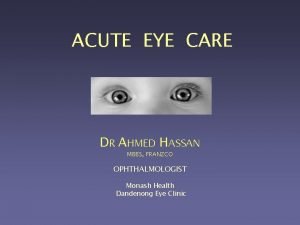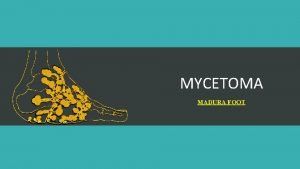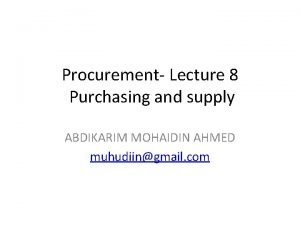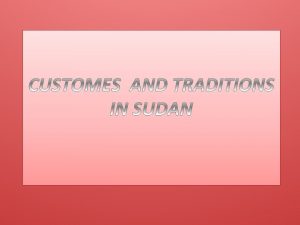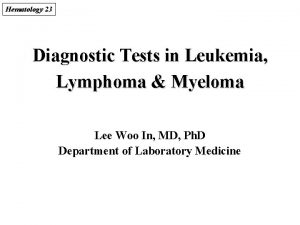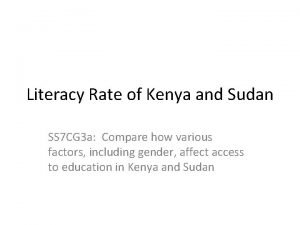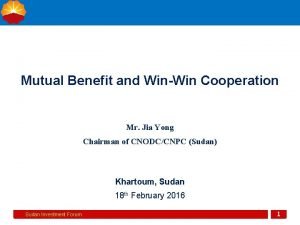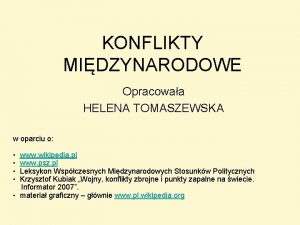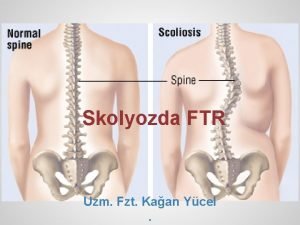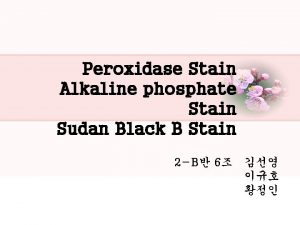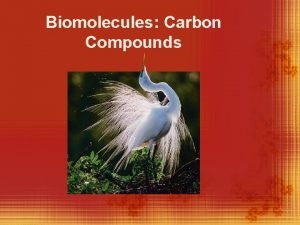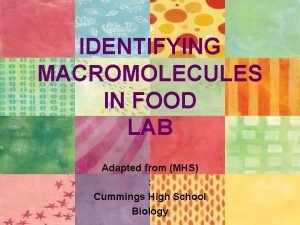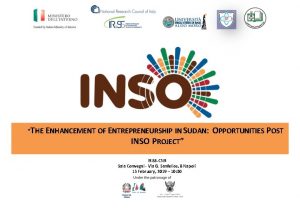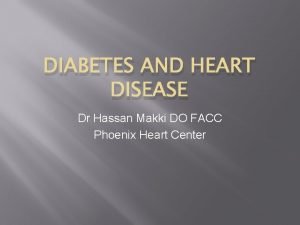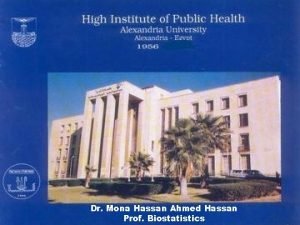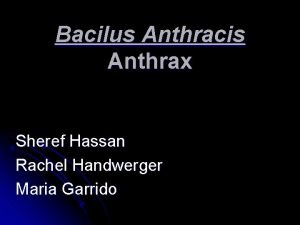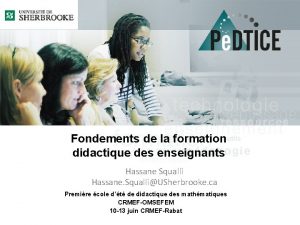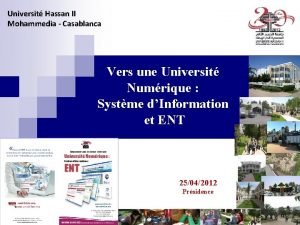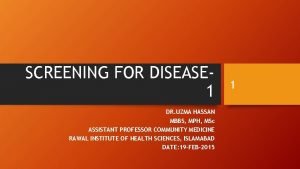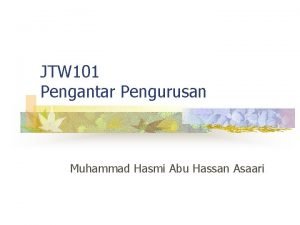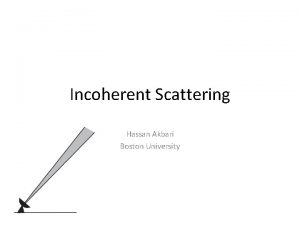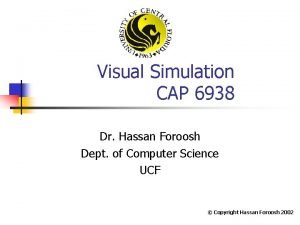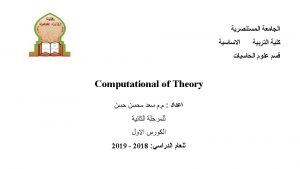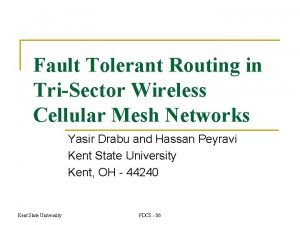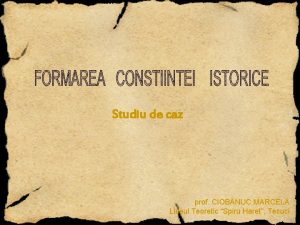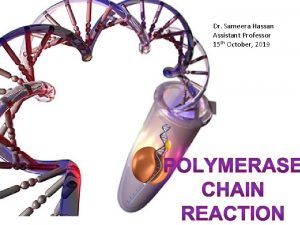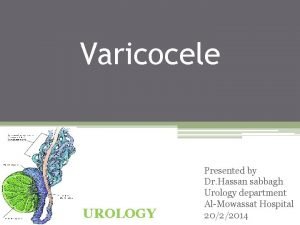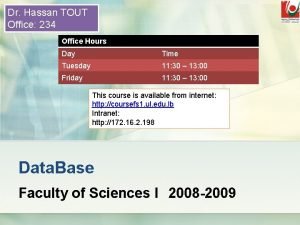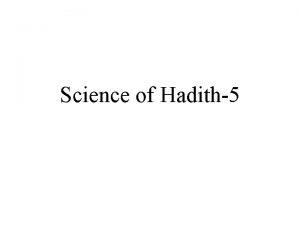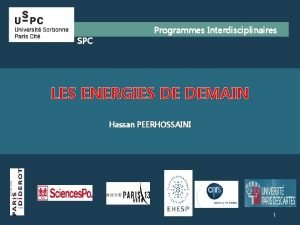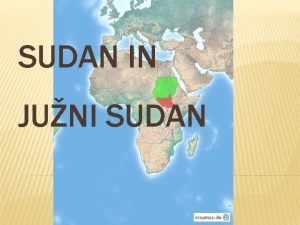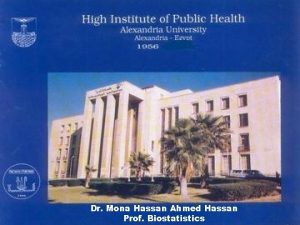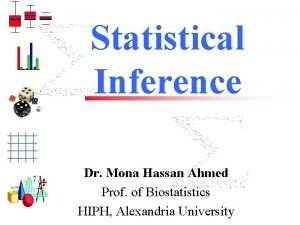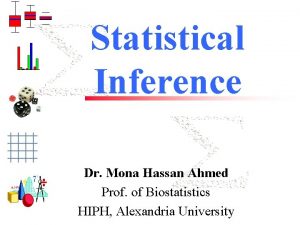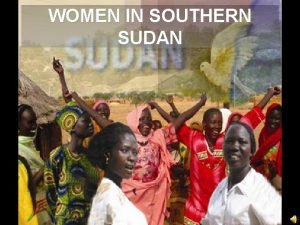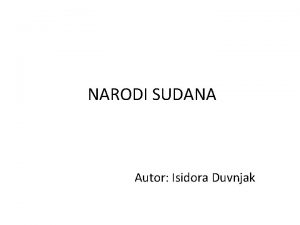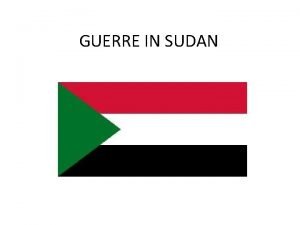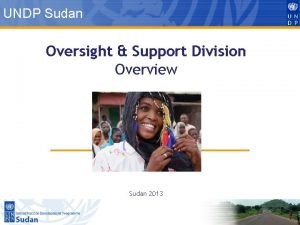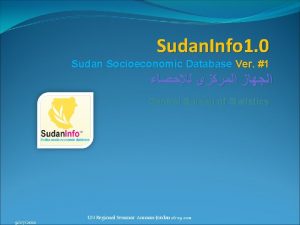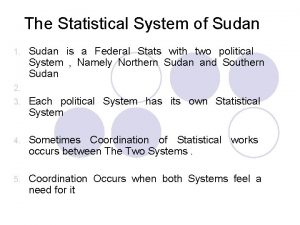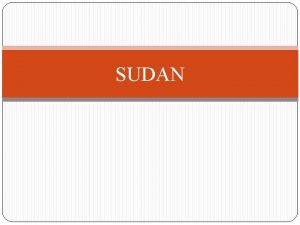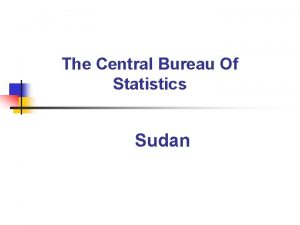Mycetoma In Sudan Prof Ahmed M EL Hassan





































































- Slides: 69

Mycetoma In Sudan Prof. Ahmed M. EL Hassan Emeritus Professor of Pathology Mycetoma Research Group Institute of Endemic diseases University of Khartoum

OBJECTIVES The objectives of this presentation are to describe and discuss: • The history of mycetoma research and services on mycetoma in Sudan • The clinical features, pathology and immunopathology of M. mycetomatis in Sudan • The strategies used by the fungus to evade these responses • Describe the structure of the causative agent at the light and ultrastructural levels.

RATIONALE • Until recently very little was known about the detailed pathology, pathogenesis and immunopathology of mycetoma. • An understanding of these processes and a proper characterisation of the host/ mycetoma agent interaction may § explain the chronicity of mycetoma and may § help in the development of better therapeutic and preventive interventions

History of Research & Services on Mycetoma In Sudan. • The term mycetoma was created by a Professor of Anatomy and Physiology called Carter when he was working in India • Before that the term Madura foot was used because the disease was prevalent in the district of Madura in India • Several cases were documented in India over the years. An author named Carter published a monograph called “On Mycetoma or Fungal Disease of India” in 18174

History of Research & Services on Mycetoma In Sudan. • Mycetoma has a world-wide distribution. It is endemic in many tropical and subtropical countries that include Sudan, Somalia, Senegal, India, Yemen, Mexico, Venezuela, Columbia, Argentina and others. • The causative organisms in Sudan include Madurella mycetomatis, Streptomyces somaliensis, Actinomadurae and Actinomadura pelletieri. • M. mycetomatis is the most common cause of mycetoma in Sudan and is difficult to treat.

Pioneers On Mycetoma In Sudan Balfouer In 1904 was the first to report on a case of mycetoma in the Sudan. • He noted that the disease was common amongst Northern Sudanese • the foot was affected most and • the commonest type was the black grain variety.

Pioneers On Mycetoma In Sudan • Extensive studies of the two causal organisms were carried out by Dr. Albert Chalmers, Director of the Wellcome Tropical Research laboratories, together with • Captain R. G. Archibald, pathologist and • Dr. J. B. Christopherson, Director of Khartoum and Omdurman Civil Hospitals.

Pioneers On Mycetoma In Sudan • They carried out valuable systemic mycological and pathological studies of the causal organisms. • Chalmers and Archibald gave quite an elaborative and specific definition of mycetoma. For the first time they introduced the terms Maduromycoses and Actinomycoses, • proceeded afterwards to classify the mycetomas into Maduromycetoma the grains of which are composed of large segmented mycelia and Actinomycetoma with grains composed of fine non-segmented filaments.

Pioneers On Mycetoma In Sudan In 1931, Grantham-Hill, • The senior surgeon, Khartoum Hospital made a detailed clinical study of 184 cases out of which 64% were of the black variety and 36% were yellow. • Noting that the yellow type is actinomycotic and the black type is maduromycotic, he discussed the relative virulence of the two types. • He thought that the actinomycotic mycetoma was more virulent, infiltrates gradually and once it penetrates the periosteum it disseminates rapidly in bone while the black maduromycotic mycetoma forms a localized usually subcutaneous tumour. • He doubted the value of medical treatment by various drugs suggested up to that date.

Pioneers On Mycetoma In Sudan • Grantham-Hill thought that the best routine treatment was surgical, and that the key to success lies in early recognition and complete removal. • In the case of black maduromycosis the pseudo-capsule can readily be identified by its bluish colour and dissection follows its outer surface. • In the absence of sinuses an incision is made into the tumour to identify its nature. If it is found to be mycetoma, fresh instruments are taken and a circumscribing incision made at a distance at about one centimeter from the apparent margin of the growth.

Pioneers On Mycetoma In Sudan • Peter Abbott, a surgeon in Wad Medani Civil Hospital was awarded the degree of M. D. (1954) from Cambridge University on his Clinical and Epidemiological Studies of Mycetoma. • He also addressed the Royal Society of Tropical Medicine and Hygiene in London in December 1956 on mycetoma in Sudan. • Abbott sent specimens from his cases abroad to Dr. Walker's Mycological Reference Laboratory in the London School of Hygiene and Tropical Medicine and to Professor Juan E. Mac. Kinnon in Montevideo in Uruguay for mycological identification.

Pioneers On Mycetoma In Sudan • Abbott carried out in vitro trials with antibiotics against Madurella mycetomi and Streptomyces somaliensis. • He found that the growth of M. mycetomi was unaffected by chloramphenicol, oxytetracycline, carbomycin and polymyxin B. • S. somaliensis was markedly sensitive to all these antibiotics except Polymyxin B.

Pioneers On Mycetoma In Sudan • Mahgoub 1964 published for the first time an article on the serological diagnosis of mycetoma. • He also obtained a Ph. D. (1965) on Mycotic Infections in the Sudan, the major part of which was a mycological and serological study of mycetoma.

Pioneers On Mycetoma In Sudan Mr. Ibrahim Moghraby (1967) • worked for many years as a surgeon in Wad Medani Hospital, centre of endemic area for mycetoma, • presented to the 6 th Arab Medical Conference in Khartoum a study on "Mycetoma in the Gezeria, a public health problem".

More Recent Workers on Mycetoma Collaboration in research between Britain and Sudan in mycetoma started in the late 1960 s as collaboration between • • Ministry of Overseas Development, UK WHO Faculty of Medicine, University of Khartoum Sudan Ministry of Health

More Recent Workers on Mycetoma • A well-equipped laboratory was established at the Department of Microbiology of the Faculty of Medicine. • Beds were made available for the project at Khartoum North Hospital. • The project addressed epidemiology, clinical manifestations, diagnosis and treatment of mycetoma. • • The Director and initiator of the project was Professor EL Sheikh Mahgoub, Professor of Microbiology, Faculty of medicine, University of Khartoum, assisted at the time by Dr. Samia Gumaa who later became a Professor in the department.

More Recent Workers on Mycetoma Mahgoub 1964 • published for the first time an article on the serological diagnosis of mycetoma. • He also obtained a Ph. D. (1965) on Mycotic Infections in the Sudan, the major part of which was a mycological and serological study of mycetoma.

More Recent Workers on Mycetoma The Mycetoma Research Centre • In 1991 a Mycetoma Research Center was established by Professor Ahmed Hassan Fahal at Soba University Hospital of the University of Khartoum. • Professor Fahal, known for his meticulous attention to detail, established wards and a laboratory in the center. • I was working closely with Prof Fahal in his Research Center

More Recent Workers on Mycetoma Research Centre • The research included epidemiology, new diagnostic procedures and treatment modalities. • New strains of S. somaliensis were discovered. This was in collaboration with Professor M. Goodfellow of the University of Newcastle.

More Recent Workers on Mycetoma Collaboration between Britain and Sudan • Nine strains isolated from mycetoma patients and labeled as Streptomyces MORE RECENT ON MYCETOMA: somaliensis were the subject WORKERS of a polyphasic taxonomic study. COLLABORATION BETWEEN BRITAIN AND SUDAN • The organisms shared chemical markers consistent with their classification in the genus Streptomyces and formed two distinct monophyletic subclades in the Streptomyces 16 S r. RNA gene tree. • • A draft Genome Sequence of the human pathogen Streptomyces somalienses, a significant cause of Actinomycetoma was recently published by the same group.

More Recent Workers on Mycetoma Collaboration between the Netherland Sudan MORE RECENT WORKERS ON MYCETOMA: • The collaboration between the Mycetoma Research Center and the COLLABORATION AND SUDAN Netherland was initiated by. BETWEEN Prof Fahal and. BRITAIN Dr. EE Zijlstra who was then a Visiting Lecturer at the IEND. • He was supported by Professor H. Verbrugh and Professor van Belkum of the Department of Medical Microbiology and Infectious Diseases, Erasmus Medical Centre, Rotterdam University, The Netherlands.

More Recent Workers on Mycetoma Collaboration between the Netherland Sudan • Several projects that addressed various aspects of mycetoma were initiated. • MORE RECENT WORKERS ON MYCETOMA: COLLABORATION BETWEEN AND SUDAN Dr. A O Ahmed from Khartoum and Dr. van. BRITAIN de Sandy from Rotterdam obtained their Ph. Ds from Rotterdam University. • • They are now leading scientists in molecular diagnosis and genetics of Eumycetoma. • A third student is currently doing her Ph. D.

More Recent Workers on Mycetoma Collaboration between the Netherland Sudan MORE RECENT WORKERS MYCETOMA: • The collaboration had enabled several young. ON scientists to be trained in COLLABORATION BETWEEN BRITAIN AND SUDAN Rotterdam and to transfer some modern technology to Sudan. • Twenty four high quality articles were published in high impact journals. • The North-Sudan collaboration had enabled the Mycetoma Research Center to be one of a kind worldwide in patient management and mycetoma diagnosis. ”

Examining a female patient with M. mycetomatis in the hand at a village in Eastern Sinnar

Mycetoma In The White Nile • Prof Fahal discovered a focus of M. mycetomatis eumycetoma in the White Nile State about 250 Km south of Khartoum • He established a clinic and surgical theater in one of the villages • 70 patients were surgically treated • All biopsies were reported by my lab in Khartoum

Main Agents Causing Mycetoma In The Sudan Eumycetoma Actinomycetoma • Madurella mycetomatis • Streptomyces somaliensis • Actinomadurae • Actinomadura pelletieri

Foot mycetoma The diagnostic triad: • Swelling • Sinuses • Discharge containing grains • In M. Mycetomatis Grains Are Black

Pathology of Mycetoma Sinus track discharging black grains of M. mycetomatis

M. mycetomatis of the foot and leg M. mycetomatis involving the foot and the lower third of the leg. In this longitudinal section, the black fungal grains are spreading in the tissues including bones.

The spread of mycetoma • Mycetoma may spread like a malignant tumour: • Locally • By lymphatics • Rarely through blood vessels • Opposite is spread of M. mycetomatis from the foot to inguinal lymph nodes

Lymphatic spread of mycetoma • Enlarged inguinal lymph node containing grains of M. mycetomatis

Bone lesions in M. IN mycetomatis eumycetoma BONE LESIONS M MYCETOMATIS • A grain in a cavity within bone • Reactive bone around a grain

Differential diagnosis of mycetoma • The differential diagnosis includes some tumours such as Kaposi sarcoma and malignant melanoma. • Any subcutaneous mass such as thorn and foreign body granulomas, particularly in areas endemic for mycetoma, may simulate mycetoma. • Bone lesions may be confused with osteosarcoma and chronic osteomyelitis.

Madurella. MYCETOMATIS Mycetomatis MADURELLA • There are two types of grain: filamentous and vesicular • This is a histological section of filamentous type of grain of M mycetomatis. • The hyphae are embedded in cement substance containing a brown pigment

Madurella. MYCETOMATIS Mycetomatis MADURELLA • A vesicular type of grain of M. mycetomatis. • The hyphae are mainly in the periphery of the grain and are swollen, hence the term vesicular.

CLASSIFICATION HOST REACTION Classification. OF of Host Reaction Type I: • • • Central neutrophils zone around grain Middle macrophage zone Peripheral lymphocyte/plasma cell zone • • Macrophage/giant cell zone around grain Lymphocytes/plasma cells in the periphery Type II: Type III: • Epithelioid granuloma

Pathology of Mycetoma PATHOLOGY OF MYCETOMA • Neutrophils around a grain of M. mycetomatis

Pathology of Mycetoma PATHOLOGY OF MYCETOMA • CD-15 positive neutrophils around a grain of M. mycetomatis. Alkaline phosphatase stain

Inflammatory reaction around a grain of M. mycetomatis (Type I Reaction) • Part of a grain surrounded by a layer of neutrophils. • Outside this is a zone of CD 68 +ve macrophages. • They stain a brown colour. (Immunoperoxidase stain) • Part of peripheral zone just visible at the top

Host Reaction in M. Mycetomatis HOST REACTION IN M MYCETOMATIS • Lipid-containing foamy macrophages outside the neutrophil zone • Lipid is most likely derived from the grain since they too contain lipid as will be shown later

Host Reaction: Type II Reaction HOST REACTION: TYPE II REACTION • Type II reaction is characterized by the replacement of the neutrophil zone by macrophages and giant cells.

Host Reaction: Type III Reaction HOST REACTION: TYPE II REACTION • Type III reaction. Epithelioid granuloma. • In the centre is a remnant of pigment.

Fibrosis particularly after antifungal treatment is a feature of M. mycetomatis Arrows point to bands of fibrous tissue

M. Mycetomatis : Electron Microscopy § Cement substance surrounding the fungus. § The latter shows the growth of hypha within hypha as indicated by the curved lines. § The black material in the cement substance and around the hyphae is melanin

M. Mycetomatis : Electron Microscopy • A neutrophil (arrow) has penetrated deep within a grain

M. Mycetomatis : Electron Microscopy • A neutrophil adhering to the surface of the grain. • Note the granules of the neutrophil are being discharged into the grain.

M. Mycetomatis : Electron Microscopy § The grain has now fragmented as a result of the action of the neutrophils § Neutrophils are the first cells that damage grains and they die in the process § They are followed by the scavenger macrophages which clear the debris

M. Mycetomatis Pathology • Despite the fact that some grains are completely destroyed by neutrophils these do not completely destroy all grains in symptomatic patients • We do not know if in endemic areas some patients may succeed in completely eradication the disease • There is a need to address this issue by further studies

Host Reaction: Ig. G in a Grain • Ig. G coating fungal hyphae. Immunoperoxidase stain.

Host Reaction: Complement in a Grain • Complement component CD 3 on the surface of the grain and intact hyphae within the grain. Immunoperoxidase stain.

Mycetoma Pathology • I shall show later that the deposition of immunoglobulins and the activation of complement is on the melanin layer on the surface of hyphae • Thus lysis of hyphae by complement does not appear to destroy the grain • Complement attracts neutrophils which can do the job committing suicide as they destroy the grain

Bone Lesions in M. Mycetomatis mycetoma BONE LESIONS IN M MYCETOMATIS • Sequestrum in the bone

Vascular Changes In Mycetoma VASCULAR CHANGES IN MYCETOMA • A vein with a narrow lumen and thick muscle layers

Exploration of the structure of M. mycetomatis: Melanin § Photomicrography shows melanin in the grain § The hyphae at the periphery of the grain are covered with melanin Masson-Fontana stain for melanin x 40).

Exploration of the structure of M. mycetomatis: Melanin • photomicrography shows cements substance and hyphae staining a blue colour with Schmorl’s stain for melanin (Schmorl’s stain x 40).

Function of melanin • We have shown here that complement activation occurs in grains but there is no direct damage to the hyphae because the activation occurs on the melanin layer • However, activated complement attracts neutrophils which damage hyphae by their strong enzymes concentrated in the neutrophil granules.

Calcium in the grain CALCIUM IN THE GRAIN • Photomicrography shows the hyphae and cement substances are positive for calcium (Von Kossa stain x 40).

Biochemical studies of grains from 80 patients infected with M. mycetomatis • Both grains and cultured hyphae were negative for sugars • Both tests for protein and Sudan ΙΙΙ test for fat were positive with both the grains and cultured mycelia. • • This may indicate that fungal grain consisted mainly of fat and proteins.

Concentration of metals in grains • Atomic Absorption Spectrophotometry (AAS) was used to determine the concentrations of several metals in the grains and the surrounding tissue and the controls. • The concentrations of Cu, Zn, and Ca in the grains were four, six and sixteen times higher respectively than in normal control tissues (p<0. 05). • There were no significant differences in the Fe, Ni and Co concentrations between the patients and control, (p>0. 05).

Function of melanin • Proteins and lipids are known to contribute to the virulence of some fungi. • M. Mycetomatis most probably uses this melanin as a protective mechanism which enhances the fungal survival. • This is in line with that reported by behnsen who suggested that, the fungal melanin protects the fungi from various host defense mechanisms such as the hydrolytic enzymes, free radicals, redox buffering, • and from the host defensive proteins such as antibodies and complement by binding them with melanin or by polymerized melanin covering cell wall linkages

Function of melanin • The M. mycetomatis melanin also acts as an anti-oxidant agent and it resists the antifungal effects of Ketoconazole and Itraconazole. • This is documented by the fact that, adding isolated melanin to the culture medium results in elevation of the minimum inhibitory concentrations of these antifungal agents.

The mean values of the heavy metals concentrations in the patients’ biopsies & the control Metals Normal tissue (Mean/ppm) Grains Mean/ppm Cu 0. 04 ± 0. 018 2. 7 ± 1. 15 Zn 0. 34 ± 0. 1 7. 6 ± 4. 8 Ca 1. 20 ± 0. 15 52. 1 ± 17. 6 Fe 4402. 9 ± 336. 7 6795. 4 ± 2753. 9 • Pb, NI, Co were not detected in normal tissue and grains

Treatment of eumycetoma • Madurella mycetomatis is the most common aetiologic agent of eumycetoma worldwide. • Treatment of this infection is very difficult and associated with high recurrence rates and low cure rates. • Currently the treatment consists of a combination of surgery and antifungal therapy. Antifungal therapy is usually given for at least one year.

Treatment of eumycetoma • The commonly used antifungal ketoconazole is too expensive for many patients in endemic countries and has many side effects. • A study evaluated the in vitro activity of the new antifungal agent ravuconazole against M. mycetomatis. • The drug showed excellent in vitro activity against all tested strains and its prodrug, E 1224, might be a potential new therapeutic option for eumycetoma caused by M. mycetomatis.

Treatment of eumycetoma: Artemisinin & tea tree oil in the treatment of eumycetoma: in vitro test • Artemisinin was not active against M. mycetomatis, but tea tree oil did inhibit its growth. • Since tea tree oil's prime component easily penetrates the skin, tea tree oil could be a useful agent in the treatment of Eumycetoma.

References 1. van de Sande WW, Luijendijk A, Ahmed AO, et al. . Testing of the in vitro susceptibilities of Madurella mycetomatis to six antifungal agents by using the Sensititre system in comparison with a viability-based 2, 3 -bis(2 methoxy-4 -nitro-5 -sulfophenyl)-5 -[(phenylamino)carbonyl]-2 H-tetrazolium hydroxide (XTT) assay and a modified NCCLS method. Antimicrob Agents Chemother 2005; 49: 1364 -8. 2. Wendy W. J. van de Sande 1, Ahmed H. Fahal, Thomas V. Riley, Henri Verbrugh and Alex van Belkum. 1093. In vitro susceptibility of Madurella mycetomatis, prime agent of Madura foot, to tea tree oil and artemisinin Antimicrob. Chemother. (2007) 59 (3): 553 -555. doi:

REFERENCES • 3. Fahal AH, El Hassan AM, Abdelalla AO, Sheik HE, Cystic mycetoma: an unusual clinical presentation of Madurella mycetomatis. Trans R Soc Trop Med Hyg. 1998; 92: 6 -67. • 4. EL Hassan AM, Fahal AH, EL Hag IA, Khalil EAG. The pathology of mycetoma: Light microscopic and ultrastructural features. Sudan Med J. 1994; 32: 23 -45. • 5. Fahal AH, EL Toum EA, EL Hassan AM, Gumaa SA, Mahgoub ES. A preliminary study on the ultrastructure of Actinomadura pelletieri and its host tissue reaction. J Med Vet Mycol. 1994; 32: 343 -348. PMID: 7844700. • 6. Fahal AH, Sheikh HE, EL Hassan AM. Pathological fracture in mycetoma. Trans R Soc Trop Med Hyg. 1996; 90: 675 -676. PMID: 9015513. • 7. Fahal AH, Sharfi AR, Sheikh HE, EL Hassan AM. Mycetoma: Uncommon complication. Trans R Soc Trop Med Hyg. 1996; 89: 550 -552. •

REFERENCES 1. Ahmed AO, Mukhtar MM, Kools-Sijmons M, Fahal AH, de Hoog S, van den Ende BG, Zijstara, ED, Verburgh H, Abugroun ESA, EL Hassan AM, van Beklkum A. Development of a speciesspecific PCR RFLP procedure for the identification of Madurella mycetomatis. J Clin Microbiol. 1999; 37(10): 3175 -8. PMID: 10488173. [ 2. EL Hassan AM, Fahal AH, Ahmed AO, Ismail A, Veress B. The immunopathology of actinomycetoma lesions caused by Streptomyces somaliensis. Trans R Soc Trop Med Hyg. 2001: 95(1); 89 -92. PMID: 11280076 3. EL Hassan AM, Fahal AH, Veress B. Cell phenotypes, immunoglobulins, and complement in lesion of eumycetoma caused by Madurella mycetomatis. Sud J Dermato 2006; 4 (1): 2 -5. 4. Fahal AH, Rahman I A, El-Hassan AM, EL Rahman ME, Zijlstra EE. The efficacy of itraconazole in the treatment of patients with eumycetoma due to Madurella mycetomatis. Trans R Soc Trop Med Hyg. 2011; 105(3): 127 -32. 5. Hmed Mohamed EL Hassan, Ahmed Hassan Fahal Wendy W van de Sande. A histopathological exploration of madurella mycetomatis grain. Plos/one 2013. DOI 1371/Journal pone 0057774 6.

REFERENCES • Mahgoub E, Murry Ian. Mycetoma 2 nd Edition Mehta Publishers. Mehta House A-16. Naralna. Phase II. New Delhi 110028 • Mycetoma Research Center, University of Khartoum website: www. mycetoma. edu
 Foreign object in eye
Foreign object in eye Mycetoma
Mycetoma Mycetoma
Mycetoma Ahmed muhudiin ahmed
Ahmed muhudiin ahmed Myelobast
Myelobast Sudanese hospitality
Sudanese hospitality Sudan black
Sudan black Organizacion celular
Organizacion celular Kenya literacy rate
Kenya literacy rate Winwin south sudan
Winwin south sudan Sudan darfur konflikt referat
Sudan darfur konflikt referat Gövde hiperekstansiyonu
Gövde hiperekstansiyonu Fonksiyonel skolyoz egzersizleri
Fonksiyonel skolyoz egzersizleri Karanlık gecede kara sudan zap suyuna giden yol
Karanlık gecede kara sudan zap suyuna giden yol In sudan
In sudan Ust sudan
Ust sudan Wright stain 원리
Wright stain 원리 Sudan iii indicator biomolecules
Sudan iii indicator biomolecules Sudanese electricity transmission company
Sudanese electricity transmission company Macromolecule indicator tests
Macromolecule indicator tests Inso south sudan
Inso south sudan Bec curriculum in the philippines
Bec curriculum in the philippines National audit chamber sudan
National audit chamber sudan Hassan makki
Hassan makki Dr mona hassan
Dr mona hassan Anil hassan
Anil hassan Marwan hassan mustafa
Marwan hassan mustafa Fatima el hassan
Fatima el hassan Syed afaq hassan solicitor
Syed afaq hassan solicitor Bassidi hassan
Bassidi hassan Hassan kite runner
Hassan kite runner Dr sheref hassan
Dr sheref hassan Local guide program
Local guide program Amanda hassan
Amanda hassan Professionisme
Professionisme Hassan sayyadi
Hassan sayyadi Hassan fareed physics
Hassan fareed physics Hassan mokhlis
Hassan mokhlis Hassan amjahad
Hassan amjahad Uh2 ent
Uh2 ent Descriere literara
Descriere literara Junaid hassan
Junaid hassan Dr uzma hassan
Dr uzma hassan Muhammad hasmi abu hassan asaari
Muhammad hasmi abu hassan asaari Hassan takabi
Hassan takabi Affine cipher
Affine cipher Hassan ben moussa
Hassan ben moussa Hassan chafi
Hassan chafi Anhar hassan
Anhar hassan Glomerular colloid osmotic pressure (gcop) is created by:
Glomerular colloid osmotic pressure (gcop) is created by: Bad writing examples
Bad writing examples Dr nada hassan syed
Dr nada hassan syed Hassan akbari
Hassan akbari Khaled hosseini hassan
Khaled hosseini hassan Hassan foroosh
Hassan foroosh Universal themes about sacrifice
Universal themes about sacrifice Saad mohsen ٨- احذر احذر
Saad mohsen ٨- احذر احذر Hassan peyravi
Hassan peyravi Comparati baladele pasa hassan
Comparati baladele pasa hassan Mahmood ul hassan islamic aid
Mahmood ul hassan islamic aid Waheed ul hassan
Waheed ul hassan Dr fatima sameera
Dr fatima sameera Ayaz ul hassan
Ayaz ul hassan Dr hassan abdalla
Dr hassan abdalla Grading of varicocele
Grading of varicocele Hassan tout
Hassan tout Triploblast
Triploblast Hassan hadith
Hassan hadith Hassan peerhossaini
Hassan peerhossaini The hajji
The hajji
